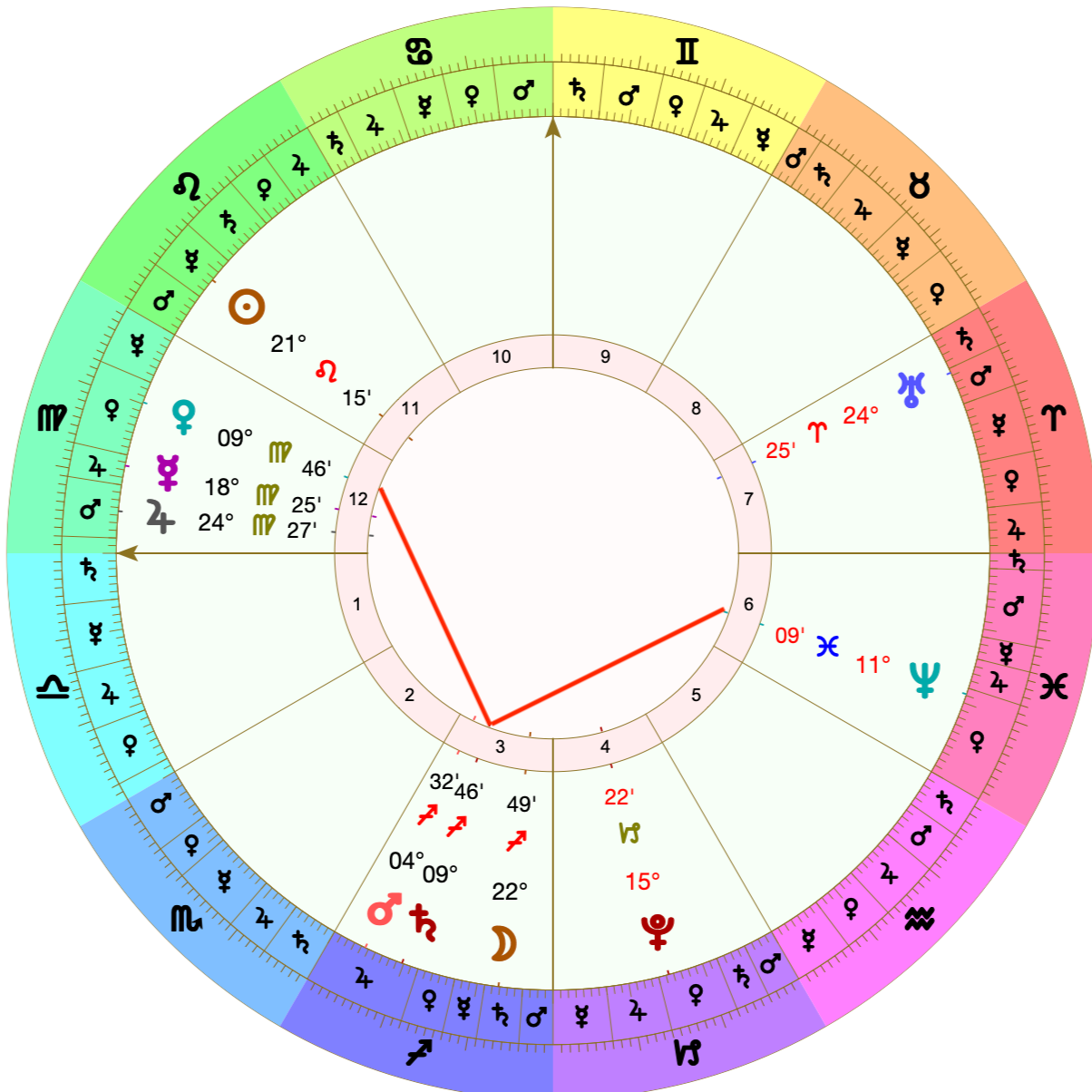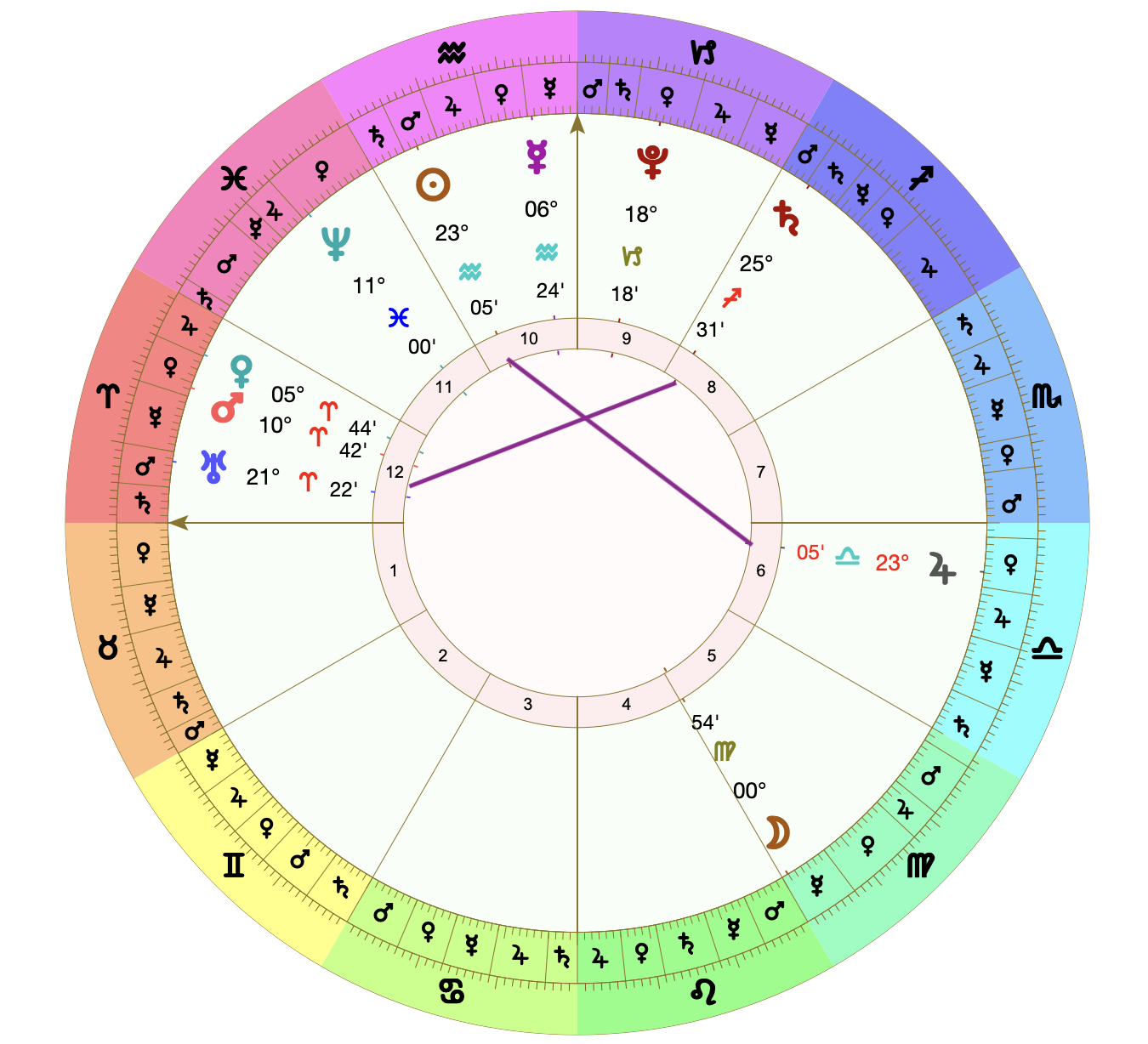Astrology 101: Aspects
Aspects in astrology are how the planets interact with each other. You’ve already learned what the planets mean, what the signs mean, and what the houses mean - but none of those meanings live in isolation. Planets cast “rays” of light across the chart, creating relationships with other planets, and merging meanings and house topics together.
Planets can interact with each other by helping each other out, especially if they’re on the same team. Benefic planets can provide resources, good luck, and positive outcomes to other planets if they are in an aspect with each other. Malefic planets can also provide resources, but maybe some hardships and more difficult outcomes depending on the aspect the malefic makes with another planet.
The key in Hellenistic astrology is to determine if the planets aspect each other or not. If a planet does not have one of the five aspects below to another planet, then we say that it is in aversion or has no aspect. Planets that are in aversion to each other cannot see each other, and it acts almost like a blind spot. They aren’t able to help each other out, and they cannot provide resources to each other, and operate independently.
The five “major” or main aspects in Hellenistic astrology are:
Conjunction - 0°
Sextile - 60°
Square - 90°
Trine - 120°
Opposition - 180°
Conjunction
A conjunction is also known as “copresence” and occurs whenever two planets occupy the same sign or when two planets are close to the same degree in the zodiac.
This originally was not considered an aspect between there’s no casting rays of light from one planet to another, instead they are simply in the same house (zodiac sign) at the same time. In Hellenistic astrology, two planets are in conjunction with each other if they are in the same sign even if they are very far apart (like the Moon at 29° Gemini is conjunct Venus at 2° Gemini).
Using the house analogy, this would be similar to both of the planets inside the same house but in rooms far apart from one another.
But the closer the planets come together to the same degree, the stronger the conjunction will be felt between the two. It will be more obvious when the Moon and Venus are both at 15° Gemini, like they’re sitting right next to each other in the house.
When interpreting a conjunction, you are blending the significations of the two planets together. Conjunctions are not inherently good or bad aspects, they are considered neutral and depend on the deposition of the planets involved. So in our example with Venus and Moon, this will probably be a “nice” transit because Venus (a benefic) and Moon (luminary that is on Venus’ team) go well together. This could bring an emotionally supportive relationship to light.
Sextile
A sextile happens when two planets are 60° apart from each other. This is a more positive, easy aspect that is ruled by Venus, so it has the nature of Venus where it connects planets to a mutual relationship. The planets are working together and assisting each other in a way that is helpful to both, however it is more mild and less obvious than the trine aspect.
Generally sextiles are considered “supportive". If Mercury is sextiling Mars, Mercury is using words, thoughts, and ideas to support Mars’ actions, goals, and motivations. They are working together and are in conversation with each other, offering a lending hand to each of their goals.
Similar to conjunctions, sextiles can also be sign-based as well as degree-based. An example below of a degree-based sextile is the Moon at 10° Aquarius sextiling Saturn at 10° Sagittarius. But in this same chart, the entire sign of Aquarius also sextiles the entire sign of Sagittarius, and also Aries. The degree-based sextile will just be more potent, powerful, and noticeable than the sign-based sextiles.
All earth signs sextile all water signs and vice versa. This is because they have an affinity for being in the same gender or expressions, which is yin, passive, or feminine.
Moon exact sextile to Saturn, sign-based sextile to Uranus.
All fire signs sextile all air signs and vice versa. This is because they have an affinity being in the same expression of yang, active, and masculine.
So in the above example, the Moon at 10° Aquarius will also sextile Uranus at 23° of Aries by sign, and they will be in an exact degree-based sextile when the Moon reaches 23° of Aquarius, where they will be exactly 60° apart from each other.
Square
Squares occur between planets when they are 90° apart from each other. This is a more difficult aspect that creates conflict, frustration, and disagreements as the two planets in this aspect are needing conflicting support. One planet may have to compromise against the other, or if both planets demand equal attention the interests will clash. A square is ruled by Mars, and similarly holds the same nature of Mars.
You generally see the disagreement of interest between the house themes represented by the zodiac sign the planets are placed in, but you can also notice the contention between planetary significations. For example, Jupiter squaring Mars will present conflicts between wanting to expand in abundance and ease, learn new things, and enjoy philosophical debates (Jupiter) while Mars will want to face hardship, work out, or take an important action instead.
Malefics will be much more difficult under a square aspect, and benefics may be somewhat problematic or potentially helpful depending on the circumstances.
One planet will always have the upper hand in a square aspect. This is known as “overcoming.” For example, if Jupiter is placed in Taurus and Mars is placed in Aquarius, these two planets square each other and Mars is overcoming Jupiter because he is in the position earlier in the zodiacial order (or otherwise known as on the “right-hand” side).
Whichever planet that overcomes the other will generally have a more dominant influence in the square aspect, and be able to push for their significations with more success than the other planet in the aspect.
Just like the other aspects, squares can be degree-based or sign-based. Signs that square each other share the same modality (mutable, fixed, or cardinal) but differ in terms of expression/gender (sextiles share expression). The difference of expression creates a conflict for each of the planets wanting to express their modality.
The entire sign of Taurus squares Aquarius and Leo and vice versa. Aries squares Cancer and Capricorn, and vice versa. Gemini squares Virgo and Pisces, and vice versa. Scorpio squares Leo and Aquarius, Libra squares Cancer and Capricorn, and Sagittarius squares Virgo and Pisces (and vice versa).
Venus in exact square to Saturn, Neptune in sign-based square to Mars, Saturn, Moon.
Squares can also be degree-based, as you see in the above example where Venus is at 9° Virgo and squares Saturn at 9° Sagittarius. Saturn, however, is in the overcoming position in this square and will have a more dominant influence. Squares at exactly 90° are the most potent, powerful, and conflicting aspects, but Hellenistic astrology will also want to pay attention to sign-based squares.
In this example, all the planets in Virgo (Venus, Mercury, and Jupiter) are all squared by the planets in Sagittarius (Mars, Saturn, and the Moon). The planets in Sagittarius are in the overcoming position and have more influence. However, the planets in Sagittarius are also squared by Neptune in Pisces, who is in the overcoming position to Sagittarius.
Trine
The most supportive and positive aspect that has the most powerful flow of energy is the trine, which is when planets are 120° apart from each other. Trines are ruled by Jupiter, and have the nature of abundance and unrestricted flow of energy. Generally when two planets are in a trine with each other, they are able to give their best efforts to another planet in a constructive fashion. Sometimes it is said that malefics are unable to cause harm in a trine aspect.
For example, when Saturn trines Venus, there is constructive support from Saturn who can provide deep commitments, powerful assistance, and loving containment to a relationship or partnership (represented by Venus). This can symbolize a long-term relationship that can withstand any challenges or hardships. Or one may choose to deepen a commitment to a value or creative part of themselves that they wish to nurture.
Trines are formed between signs that share the same element. All the water signs (Pisces, Cancer, Scorpio) trine each other, as well as all the Fire signs (Sagittarius, Aries, Leo). Same with Earth and Air.
Sun in exact trine to Jupiter, Saturn in sign-based trine to Venus, Mars, and Uranus
Just like the other aspects, trines are sign-based as well as degree-based. In the above example, the Sun at 23° Aquarius is in an exact trine to Jupiter at 23° Libra. But the planet Mercury at 6° Aquarius is also in a sign-based trine to Jupiter in Libra. Saturn at 25° Sagittarius is in a sign-based trine to Venus, Mars, and Uranus in Aries. Trines at the exact 120° mark will be the most potent, but sign-based trines are also important to examine.
Opposition
The final major aspect between planets is the opposition, which is when two planets are 180° apart from each other. This is another challenging aspect that is often described as hostile or adversarial, and it is ruled by Saturn. Oppositions create a gridlock between two planets, who each have opposing views or goals, and can cause harm to each other. Malefics especially are considered to be damaging and harmful under an opposition, while benefics are described as less positive and unable to access their ease in this position.
Like a square, opposing signs share the same modality (fixed, mutable, cardinal), but unlike a square they also share the same expression/gender. They usually represent two opposite seasonal experiences. For example, Leo is the heart of Summer in the Northern hemisphere (July-August) and opposes Aquarius, who is the heart of Winter (January-February).
Planets in oppositions are usually torn between two different directions and often end up getting in conflict with each other to the point they are unable to act out their significations. For example, if the Sun is opposite Mars, the native may be dealing with a lot of internal conflict about themselves, fighting some internal battle with their identity and self-perception, and unable to move forward with their goals.
Jupiter exact opposition to Mercury and sign-based to Aries
Oppositions are also degree-based and/or sign-based. Here, Jupiter at 20° of Libra is exactly opposite Mercury at 20° Aries. This is the most potent opposition and frustration point between the two planets. However, Jupiter at 20° Libra also opposes the other planets in Aries by sign (Uranus, Venus, and the Sun).
Applying versus Separating?
As you’ve learned in the previous examples, all aspects can be degree-based or sign-based. For sign-based aspects, it’s also helpful to determine if the aspect is applying (or moving towards the exact aspect) or separating (and moving away from the exact aspect).
In our last chart example, the Sun and Venus are in the earlier degrees of Aries and are said to be applying to an opposition with Jupiter (technically Venus is retrograde, but we will ignore that for the sake of this example). Uranus is past the 20° mark, so it is technically separating from the opposition with Jupiter.
Applying aspects are important to note when doing transit readings because it often describes an aspect that is building or will come to happen, especially in terms of Moon aspects. Separating aspects in transit charts generally describe an aspect that has happened and you’re still feeling the effects of. This is NOT always the case, but is a general rule of thumb.
Orbs for Degree-based Aspects
Most astrologers choose to focus more on degree-based aspects, as those aspects show the most potent planetary connections and conversations. To do so, many astrologers add what is called an “orb” to focus on.
For example, a common orb for all planets (except for the Moon) is about 3° for Hellenistic astrologers. Meaning if the exact aspect between Mercury and Jupiter is 20°, then when Mercury is 17°, or 3° away from the exact opposition, Mercury is considered in orb and the degree-based aspect is in affect.
The same is for when Mercury is at 23°, and in the example, Uranus at 23° Aries is also within a 3° orb to the opposition with Jupiter at 20° Libra.
For the Moon, most astrologers tend to use a 13° orb as that is the average amount of degrees the Moon covers in one day.
Orbs are ultimately personal to each astrologer, and if you’re practicing Hellenistic astrology you should also look at sign-based aspects to begin with, then narrow your orbs down and see what degree-based aspects appear to you. Both will provide helpful information and insight on how the plants are interacting with each other.
—
Enjoyed this? Read the other Astro 101 blog posts! Want to learn more about your chart and transits? Book a reading here with me!




